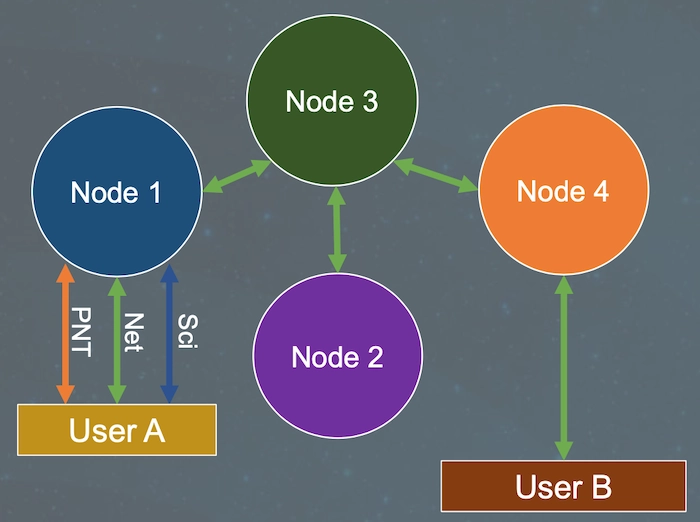Humans will be back on the Moon by 2024. Artemis missions are being carefully planned to get us there, with the goal of achieving permanent presence and also prepare us for the next step in human presence in space: Mars.
Can you imagine Earth without Internet? NASA cannot imagine the Moon without Internet either, that's why Goddard Space Flight Center took the previous advances in space networking and conceptualized LunaNet: a Flexible and Extensible Lunar Exploration Communications and Navigation Infrastructure.
LunaNet is an Internet-like architecture which will support coming lunar missions. It will provide communications services, positioning, navigation and timing (PNT) services, Science and Detection and other services, for lunar science and exploration orbiters, lunar mobile and stationary surface systems, Moon and Earth relay systems, lunar ascent and descent vehicles, in addition to the control centers and ground stations on Earth. LunaNet is Moon's network to Earth.

Figure. With LunaNet, User A (on Moon) can receive network, PNT, Science (detection and others not shown) services from Node 1 and communicate with User B (local or on Earth). From NASA.
In terms of communications, LunaNet is a network supporting Delay and Disruption Tolerant Networking (DTN). Why DTN? Although the delay introduced by the distance between Moon and Earth, i.e. One Way Light Time (OWLT) is ~1.3 seconds (long but still good enough to run TCP/IP), LunaNet will require support for disruptions that will be inherent to the early network (with few relays/nodes) and to the location of the mission (think about the far side of the Moon). It is also expected LunaNet will support TCP/IP in many segments of its end-to-end network. Initial Moon surface systems (i.e. rovers) will rely on satellite relay services to connect to Earth, followed by Moon stations with direct link to Earth (e.g. future Tranquility station). In terms of bandwidth/throughput, it is expected to support data rates high enough for multiple simultaneous video streams. One of the key communications requirements is to support bandwidth for video transmitted during Astronauts Extravehicular Activities (EVA).
LunaNet Positioning, Navigation and Timing (PNT) services enable surface navigation, location tracking including Search and Rescue, time reference distribution, relative navigation, autonomy, and traceability to GPS time. Due to the homogeneity of features and colors on the Moon, visual references have proven not good enough to perform EVA. For example, on Apollo 14 EVA 2, the crew got lost when trying to reach the rim of Cone crater and had to return to save oxygen and supplies to return to the lander. Later, high res satellite pictures revealed they were within 30 yards of the rim!
With NASA and space exploration in general, it is all about safety. The Detection services will provide early warning of solar event onset, i.e. detection of a solar mass ejection which could be extremely dangerous for Astronauts. It is now known that Apollo missions fortuitously managed to avoid extreme interplanetary conditions which occurred on 1969 and 1972.
As you may imagine, LunaNet will be built over time, so its elements will provide all or partial service interfaces, e.g. there may be elements providing only PNT services, while others would focus on Communications and Science/Detection services. Also in its configuration, it is expected a wide range of elements such as Small to large satellites, integrated relays in the Lunar Gateway and ground stations on both sides. Due to its DTN support, networking will be flexible, adapting to the ever-growing topology.
NASA is the main proponent for LunaNet as an architecture. This architecture however, aims to support international standards for interoperability, and envisions the concept of LNSP, or LunaNet Service Provider. . So, basically NASA, ESA, JAXA and any commercial operator can become LNSP as they provide communications, PNT and other services to lunar surface elements. If you think this may be too far out, consider humans will land again on the Moon four years from now, and because of that NASA released early October 2020 a Request for Information (RFI) for Lunar Communications Relay and Navigation Services to cover a science mission to the far side of the Moon and a human mission to its south pole, both scheduled for 2024. In the RFI, NASA's preference is to (a) obtain these services through a Fee-for-Service contract, (b) for the provider to be a full LNSP, which includes use of commercial relay and ground stations instead of NASA space networks (including Space Network and Deep Space Network). As it is an RFI, it is early to say whether commercial providers would have a good enough "short-term" business case (return of investment) to create the complete early segments of LunaNet. It is also possible LunaNet starts being built with commercial infrastructure for certain segments (e.g. satellite relays) connected to NASA and other agencies Earth systems. LunaNet, a stepping-stone to build the Interplanetary Internet.
Header illustration showing Positioning, Navigation, Timing (PNT) and Detection services on a client on the Moon. Property of NASA.
Header illustration showing Positioning, Navigation, Timing (PNT) and Detection services on a client on the Moon. Property of NASA.
